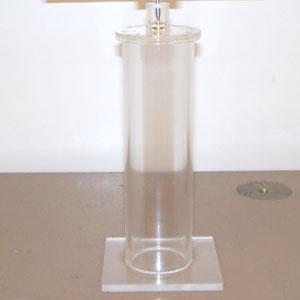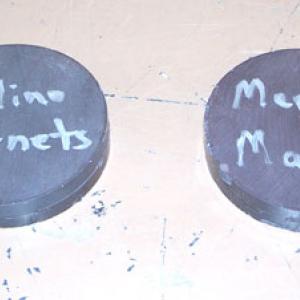College of Liberal Arts & Sciences
5G10.10 - Magnets
Video Credit: Jonathan M. Sullivan-Wood
The magnet on the swivel may be used to show a magnetic motor. The diffusion pump magnets can be strung together and then used to show how breaking a magnet in two creates two magnets.
- Edward Russell Forringer, "Measuring and Modeling the Force Between Permanent Magnets", TPT, Vol. 60, #7, Oct. 2022, p. 546.
- Wayne Mark Saslow, "Magnetic Poles: A Missing Manual", TPT, Vol. 60, #7, Oct. 2022, p. 540.
- Tracy Hood, "A New Direction: How a Compass Pointed The Way to Clearing Up an Attractive Misconception", TPT, Vol. 50, #7, Oct. 2012, p. 398.
- Peter Froehle, "Quick Way to Float a Paper Clip on Water", TPT, Vol. 46, #2, Feb. 2008, p. 70.
- Kerry Browne and David P. Jackson, "Simple Experiments to Help Students Understand Magnetic Phenomena", TPT, Vol. 45, #7, Oct. 2007, p. 425.
- Al Adams, "Spherical Rare-Earth Magnets in Introductory Physics", TPT, Vol. 45, #7, Oct. 2007, p. 409.
- Michael J. Moloney, "Strong Little Magnets", TPT, Vol. 45, #6, Sept. 2007, p. 352.
- Lisa E. Gayetsky and Craig L. Caylor, "Measuring the Forces Between Magnetic Dipoles", TPT, Vol. 45, #6, Sept. 2007, p. 348.
- Ron Edge, "A Simple Diamagnetic Levitation Experiment", TPT, Vol. 41, #2, Feb. 2003, p. 122.
- John D. McGervey, "Hands-on Physics for Less Than a Dollar per Hand", TPT, Vol. 33, #4, Apr. 1995, p. 238.
- Evelyn Restivo and H. T. Hudson, "'Iron-Enriched' Cereal-Literally", TPT, Vol. 28, #9, Dec. 1990, p. 608.
- Robert Chasnov and Louis Overcast, "Magnet Symmetry and Newton's Third Law", TPT, Vol. 28, #2, Feb. 1990, p. 112.
- Jay Zimmerman and Howard Balfour, "Doing Physics: Dipole Repulsion", TPT, Vol. 25, #7, Oct. 1987, p. 470.
- Jay Zimmerman and Howard Balfour, "Doing Physics", TPT, Vol. 25, #7, Oct. 1987, p. 469.
- John W. Ecklin, "More on Magnetic Forces", TPT, Vol. 25, #2, Feb. 1987, p. 73.
- William Kopp, Arthur Schmidt, and Ed McNeil, "Magnetic Forces", TPT, Vol. 23, #6, Sept. 1985, p. 375.
- Dwight L. Barr Sr., "There's Still a Lot We Don't Know", TPT, Vol. 14, #9, Dec. 1976, p. 534, also A Potpourri of Physics Teaching Ideas - Electricity and Magnetism, p. 161.
- Jerry D. Wilson, "A Three-Pole Bar Magnet", TPT, Vol. 14, #6, Sept. 1976, p. 365, also A Potpourri of Physics Teaching Ideas - Electricity and Magnetism, p. 160.
- Gladys F. Luhman, Arthur R. Quinton, Dean Hartman, and Rod Fisher, "A Magnetic Tripole—What Caused It? ", TPT, Vol. 14, #5, May 1976, p. 261, also A Potpourri of Physics Teaching Ideas - Electricity and Magnetism, p. 159.
- Liberio Mar and Carlos Hernandez, "Construction of a Simple Compass", TPT, Vol. 14, #4, Apr. 1976, p. 247, also A Potpourri of Physics Teaching Ideas - Electricity and Magnetism, p. 162.
- Michael Davis, "A Magnetic Tripole", TPT, Vol. 14, #1, Jan. 1976, p. 34, also A Potpourri of Physics Teaching Ideas - Electricity and Magnetism, p. 158.
- Brother James Mahoney, "The Field Strength of A Permanent Magnet", TPT, Vol. 13, #8, Nov. 1975, p. 507, also A Potpourri of Physics Teaching Ideas - Electricity and Magnetism, p. 168.
- Walter Thumm, "Questions Some Students Ask... A Question of Magnets and Keepers", TPT, Vol. 10, #8, Nov. 1972, p. 483, also A Potpourri of Physics Teaching Ideas - Electricity and Magnetism, p. 165.
- Delbert Garrick and Raymond Kunselman, "Magnetic Monopoles", TPT, Vol. 9, #7, Oct. 1971, p. 366.
- Noel C. Little, "An Oft Forgotten Formula", TPT, Vol. 7, #8, Nov. 1969, p. 452.
- Walter Thumm, "Why Keepers on Magnets?", TPT, Vol. 6, #1, Jan. 1968, p. 38.
- Kenneth Brownstein, "Letters on Bar Magnets", AJP, Vol. 55, #1, Jan. 1987, p. 10.
- Alfred Romer, "Magnetic Repulsion: An Introductory Experiment", AJP, Vol. 41, #12, Dec. 1973, p. 1332.
- Ian Gilbert, Cristiano Nisoli, and Peter Schiffer, "Frustration by Design", Physics Today, Vol. 69, #7, July 2016, p. 54.
- C. L. Chien, Frank Q. Zhu, and Jian-Gang Zhu, "Patterned Nanomagnets", Physics Today, Vol. 60, #6, June 2007, p. 40.
- Roderich Moessner and Arthur P. Ramirez, "Geometrical Frustration", Physics Today, Vol. 59, #2, Feb. 2006, p. 24.
- "Do Magnets Go Bad? If So, How?", Popular Mechanics, Vol. 192, #5, May 2015, p. 26.
- A. H., "One Pole to Rule Them All", Popular Mechanics, Vol. 191, #6, June 2014, p. 17.
- D. Rae Carpenter Jr. and Richard B. Minnix, "B-380. Cereal & Nails (Spoof)", DICK and RAE Physics Demo Notebook, 1993.
- G. D. Freier and F. J. Anderson, "Er-2", A Demonstration Handbook for Physics.
- Tik Liem, "Which Pole is Attracted?", Investigation to Science Inquiry, p. 222.
- Robert J. Reiland, Laboratory Activity 11: "A Model of Magnetic Domains", Teaching About Magnetism, p. 3.38.
- George M. Hopkins, "Magnetism", Experimental Science, p. 356.
- George M. Hopkins, Experimental Science, Volume Two, p. 110.
- Joseph H. Adams, "Magnets and Induction-Coils", Harper's Electricity Book For Boys", p. 54.
- Vicki Cobb and Kathy Darling, "No Attraction Here", Bet You Can!, p. 39.
- Janice VanCleave, "15, Temporary", Magnets, p. 60.
- Janice VanCleave, "7, Swinger", Magnets, p. 28.
- Janice VanCleave, "4, Get Away", Magnets, p. 16.
- Janice VanCleave, "1, Stickers", Magnets, p. 4.
- James D. Livingston, "All Ten Facts about the Force", Driving Force - The Natural Magic of Magnets, p. 119.
- James D. Livingston, "Permanent Magnet Terminology", Driving Force - The Natural Magic of Magnets, p. 52.
- Jodi and Roy McCullough, "Magnetism with a Magnetic Sculpture", The Role of Toys in Teaching Physics", p. 4.46.
- Jodi and Roy McCullough, "Magnetism with Magnetic Marbles", The Role of Toys in Teaching Physics, p. 4.172.
- Pat Murphy, Ellen Macaulay, and the staff of the Exploratorium, "Magnets", Exploratopia, p. 320.
- Martin Gardner, "90. The Paper Clip Chain", Smart Science Tricks, p. 133.
- Martin Gardner, "85. Which is Which?", Smart Science Tricks, p. 126.
- "The Basics of Magnetism in Action", The Boy Scientist, p. 194.
- Simon Quellen Field, "Measures Used In Permanent Magnets", Gonzo Gizmos, p. 15 - 17.
- Christopher P. Jargodzki and Franklin Potter, "191, The Magnet", Mad About Physics, p. 72, 213.
- Christopher P. Jargodzki and Franklin Potter, "190, Why the Keeper?", Mad About Physics, p. 72, 213.
- Raymond Bruman, "Magnetic Tightrope", Exploratorium Cookbook I, p. 79.1.
- Robert Ehrlich, "9.6 - Pushing Disk Magnets on the OHP", Why Toast Lands Jelly-Side Down, p. 151 - 153.
- Robert Ehrlich, "A Row of Magnetic Marbles on an Incline", Why Toast Lands Jelly-Side Down, p. 54 - 56.
- Robert Ehrlich, "Magnet Symmetry and Newton's Third Law", Why Toast Lands Jelly-Side Down, p. 35 - 36.
- Janice VanCleave, "23, Keeper", Janice VanCleave's Physics for Every Kid, p. 54.
- Bobby Mercer, "No-Touch Race Car", Junk Drawer Physics, p. 149.
- Sara Stein, "Atom Magnets", The Science Book, p. 239.
- "The Inverse Square Law in Magnetism", Selective Experiments in Physics, CENCO, 1962.
- "Magnetic Moment and Magnetic Field Intensity", Selective Experiments in Physics, CENCO, 1962.
- "Distribution of Magnetic Field Lines of Force Near the Surface of a Bar Magnet", Selective Experiments in Physics, CENCO, 1958.
- Rudolf F. Graf, "What Will a Magnet Attract?", Safe and Simple Electrical Experiments, p. 42.
- Rudolf F. Graf, "Like Poles Repel and Unlike Poles Attract", Safe and Simple Electrical Experiments, p. 48.
- Rudolf F. Graf, "Which Magnet is Stronger", Safe and Simple Electrical Experiments, p. 50.
- Rudolf F. Graf, "Where is a Magnet the Strongest", Safe and Simple Electrical Experiments, p. 51.
- Rudolf F. Graf, "Induced and Residual Magnetism", Safe and Simple Electrical Experiments, p. 52.
- Rudolf F. Graf, "Magnetic Poles Can Be Anywhere", Safe and Simple Electrical Experiments, p. 58.
- Rudolf F. Graf, "Which One is Magnetized", Safe and Simple Electrical Experiments, p. 63.
- Rudolf F. Graf, "Rescuing the Paper Clip", Safe and Simple Electrical Experiments, p. 64.
- Rudolf F. Graf, "Magnetic Separation", Safe and Simple Electrical Experiments, p. 65.
- Rudolf F. Graf, "Make Floating Magnets", Safe and Simple Electrical Experiments, p. 66.
- Rudolf F. Graf, "How Steady Are You", Safe and Simple Electrical Experiments, p. 67.
- Rudolf F. Graf, "Building a Simple Motor", Safe and Simple Electrical Experiments, p. 67.
- Rudolf F. Graf, "Magnetic Pick-Up Sticks", Safe and Simple Electrical Experiments, p. 72.
- Herb Strongin, “Investigating the Poles of a Magnet“, Science on a Shoestring, p. 165.
- Herb Strongin, “Measuring the Strength of a Magnet“, Science on a Shoestring, p. 168.
- Borislaw Bilash II, “Magnetic Analogy for Bonding Forces“, A Demo A Day – A Year of Physical Science Demonstrations, p. 121.
- Borislaw Bilash II, “North or South?“, A Demo A Day – A Year of Physical Science Demonstrations, p. 289.
- Borislaw Bilash II, “Distance Makes It Less Fonder“, A Demo A Day – A Year of Physical Science Demonstrations, p. 295.
- Julius Sumner Miller, Q177 & A177, Millergrams II – Some More Enchanting Questions for Enquiring Minds, p. 45 & 100.
- Julius Sumner Miller, Q187 & A187, Millergrams II – Some More Enchanting Questions for Enquiring Minds, p. 51 & 103.
- Forrest M. Mims III, "Temporary Magnets, Permanent Magnets, Using and Caring for Magnets", Vol. III - Electronic Sensor Circuits & Projects, p. 60.
Disclaimer: These demonstrations are provided only for illustrative use by persons affiliated with The University of Iowa and only under the direction of a trained instructor or physicist. The University of Iowa is not responsible for demonstrations performed by those using their own equipment or who choose to use this reference material for their own purpose. The demonstrations included here are within the public domain and can be found in materials contained in libraries, bookstores, and through electronic sources. Performing all or any portion of any of these demonstrations, with or without revisions not depicted here entails inherent risks. These risks include, without limitation, bodily injury (and possibly death), including risks to health that may be temporary or permanent and that may exacerbate a pre-existing medical condition; and property loss or damage. Anyone performing any part of these demonstrations, even with revisions, knowingly and voluntarily assumes all risks associated with them.



